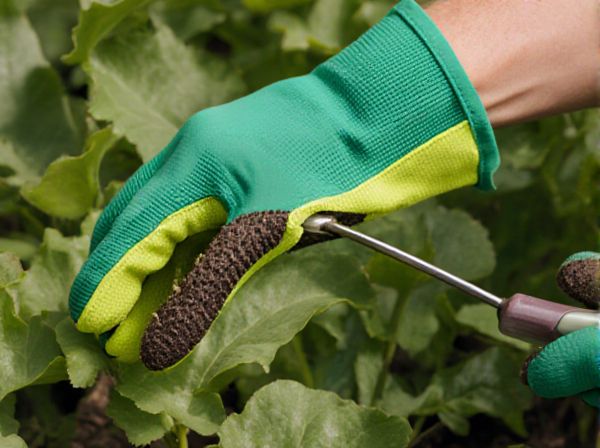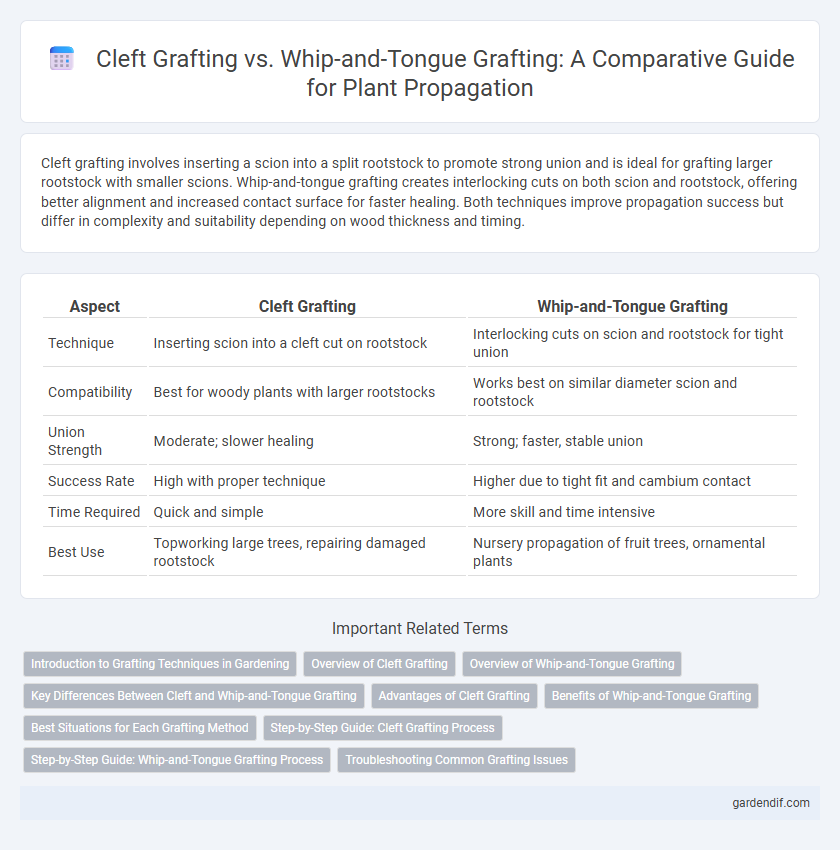
Cleft Grafting vs Whip-and-Tongue Grafting Illustration
Cleft grafting involves inserting a scion into a split rootstock to promote strong union and is ideal for grafting larger rootstock with smaller scions. Whip-and-tongue grafting creates interlocking cuts on both scion and rootstock, offering better alignment and increased contact surface for faster healing. Both techniques improve propagation success but differ in complexity and suitability depending on wood thickness and timing.
Table of Comparison
| Aspect | Cleft Grafting | Whip-and-Tongue Grafting |
|---|---|---|
| Technique | Inserting scion into a cleft cut on rootstock | Interlocking cuts on scion and rootstock for tight union |
| Compatibility | Best for woody plants with larger rootstocks | Works best on similar diameter scion and rootstock |
| Union Strength | Moderate; slower healing | Strong; faster, stable union |
| Success Rate | High with proper technique | Higher due to tight fit and cambium contact |
| Time Required | Quick and simple | More skill and time intensive |
| Best Use | Topworking large trees, repairing damaged rootstock | Nursery propagation of fruit trees, ornamental plants |
Introduction to Grafting Techniques in Gardening
Cleft grafting and whip-and-tongue grafting are essential horticultural techniques used for plant propagation, particularly in fruit trees and ornamental plants. Cleft grafting involves inserting a scion into a cleft made in the rootstock, making it suitable for larger rootstocks or repairing damaged trees, whereas whip-and-tongue grafting creates interlocking cuts for a stronger union in similarly sized rootstock and scion. Both methods promote genetic consistency and faster fruit production compared to planting from seed, enhancing overall graft success rates.
Overview of Cleft Grafting
Cleft grafting involves inserting a scion into a split made in the rootstock's stem, creating a strong union ideal for repairing damaged trees or changing cultivars. This technique is advantageous for its simplicity and compatibility with larger rootstocks, promoting rapid healing and efficient nutrient transfer. Unlike whip-and-tongue grafting, cleft grafting tolerates size differences between scion and rootstock, making it suitable for a wide range of propagation scenarios.
Overview of Whip-and-Tongue Grafting
Whip-and-tongue grafting is a precise technique commonly used for fruit trees, involving a long diagonal cut with a complementary tongue on both the scion and rootstock to increase the contact area for better vascular connection. This method enhances the stability and strength of the graft union, promoting faster healing and improved nutrient flow compared to simpler grafting methods. Ideal for young, similarly sized plant material, whip-and-tongue grafting ensures higher success rates and uniform growth in propagation.
Key Differences Between Cleft and Whip-and-Tongue Grafting
Cleft grafting involves inserting a single scion into a cleft or split in the rootstock, making it ideal for joining a smaller scion to a larger rootstock and promoting strong initial contact for vascular union. Whip-and-tongue grafting features matching slant cuts with complementary tongues on both scion and rootstock, offering greater stability and a larger cambium contact area that enhances nutrient flow and healing. The key difference lies in the cut complexity and application; cleft grafting suits top-working older or larger trees, while whip-and-tongue grafting excels in joining similarly sized young shoots for improved survival rates.
Advantages of Cleft Grafting
Cleft grafting offers greater compatibility with larger rootstocks, enabling effective repair of damaged or mature trees by inserting multiple scions simultaneously. This method provides improved stability and healing at the graft union due to the deeper insertion compared to whip-and-tongue grafting. Cleft grafting is particularly advantageous for woody plants in orchard management where rapid and robust integration is essential.
Benefits of Whip-and-Tongue Grafting
Whip-and-tongue grafting offers superior structural stability and a larger cambial contact area, which enhances nutrient flow and promotes faster healing compared to cleft grafting. This method reduces the risk of graft failure and ensures a stronger union, making it ideal for delicate or valuable plant species. The precise fit of whip-and-tongue grafts supports improved alignment of vascular tissues, resulting in more efficient propagation and higher success rates.
Best Situations for Each Grafting Method
Cleft grafting is best suited for older, thicker rootstocks where a strong union is required, especially in repairing damaged trees or joining a scion of smaller diameter to a larger rootstock. Whip-and-tongue grafting is ideal for young, similarly sized rootstocks and scions, providing a secure and well-aligned union that encourages rapid healing and growth. Choosing the appropriate method depends on the size compatibility and the specific propagation goals for optimal plant development.
Step-by-Step Guide: Cleft Grafting Process
Cleft grafting begins by selecting a healthy rootstock and a compatible scion with well-developed buds. The rootstock is cut horizontally, and a precise cleft or split is made to receive the scion, which is shaped into a wedge to fit snugly into the cleft. Secure the graft union with grafting tape or wax to prevent moisture loss and ensure successful healing and growth.
Step-by-Step Guide: Whip-and-Tongue Grafting Process
Whip-and-tongue grafting involves making a slanted cut followed by a matching tongue cut on both the scion and rootstock to ensure a secure fit and optimal cambium contact. The scion and rootstock are then carefully joined, aligned precisely, and bound tightly with grafting tape or rubber bands to prevent moisture loss and promote union. Finally, the graft union is sealed with grafting wax or a similar sealant to protect against pathogens and desiccation, enhancing the success rate compared to cleft grafting in compatible hardwood species.
Troubleshooting Common Grafting Issues
Cleft grafting often encounters issues such as poor cambial contact and moisture loss, which can lead to graft failure, while whip-and-tongue grafting typically faces problems with improper alignment and insufficient bark removal, causing weak union formation. Ensuring tight cambial contact by securely wedging the scion into the rootstock and maintaining optimal humidity levels are critical to overcoming cleft grafting challenges. For whip-and-tongue grafting, precise cuts with matching tongues and thorough removal of damaged bark improve the graft union's strength and success rate.
Cleft Grafting vs Whip-and-Tongue Grafting Infographic

 gardendif.com
gardendif.com